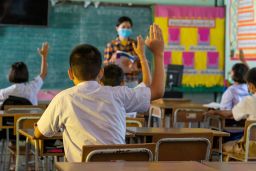With children returning to school, there’s a massive effort underway within many districts around the country to keep Covid-19 at bay. But additional issues – stress and anxiety – are finding their way in. Doctors and psychiatrists want parents to take note – children may be bringing last year’s pandemic stress into the classroom.
Anxiety, together with depression and isolation, contributed to more parents reporting mental health problems with their kids last in 2020 compared to the year prior and 31% more visits to the emergency room for mental health problems in adolescents, according to the US Centers for Disease Control and Prevention.
Dr. Carol Weitzman, a developmental behavioral pediatrician, said pandemic-related mental health problems won’t go away now that kids are back in school and hanging out with friends again.
“There’s a very big chunk of kids who will be ready to go (back to school), but we’ve got to pay attention to those kids who aren’t and think about what you need to re-enter school safely and with confidence,” said Weitzman, co-director of the Autism Spectrum Center at Boston Children’s Hospital and attending physician at the hospital’s division of developmental medicine.

Your child’s silence doesn’t always mean “stay away,” said Weitzman, who also sees patients in Connecticut at the CT Center for Developmental Pediatrics and serves as president of the Society for Developmental Behavioral Pediatrics.
As someone who spent the year talking to kids with all sorts of mental health issues, she sees this moment as an opportunity for families to strengthen their relationships and for caregivers to get better at recognizing when kids need help. Here’s her advice.
This interview has been edited and condensed for clarity.
CNN: Kids and parents are eager to return to school, but you say there’s a lot that we’ve lost. What do we still need to address with our kids?
Dr. Carol Weitzman: I think we have had a year and a half of unusual and atypical experiences and a lot of loss: loss of normal day-to-day routine, loss of social relationships, loss of learning, loss of new experiences, loss of milestone events. Now we’re going back – there’s an adjustment that has to happen to get back into a rhythm.
There are also a lot of really disturbing, upsetting and tragic things that have happened in this period, and we could go back to school with enthusiasm, but those things still happened. We have to figure out how to make sense of that and we can have co-occurring and even conflicting feelings. You can be enthusiastic. You can look forward to going back to new things and still carry with you a lot of the loss and sorrow and anxiety from things that happened. You can feel both of those things. It’s not one or the other.
CNN: The National Institutes of Health says 1.5 million children lost a close caregiver, and they are grieving. How can that show up in their behavior?
Weitzman: When it looks like grief, we are familiar with it. We’re better at recognizing it. We’re not even great at that sometimes, but we’re better at recognizing it when kids are sad, tearful or talk about their loss. Grief can look like a lot of other things, too. It can look like loss of pleasure in things. It can look like changes in our day-to-day habits, in our eating and our sleeping habits. It can look like anger. It can look like irritability. It can look like inattention. It can look like poor school performance.
When we see significant changes in functioning, getting a trauma history is just really essential, because trauma may be there. We don’t always think about it when we see angry or argumentative or oppositional and non-compliant kids. But when we see change in function, we’ve got to ask about it. If you don’t ask, we make the mistake of thinking it’s one thing, when it can really be something else.

CNN: What can parents say to start a conversation when they see a change in their kids?
Weitzman: The biggest thing is in our mindset and in how we approach kids. We need to maintain a curious, interested and nonjudgmental stance toward kids, so that we really convey we are interested in just learning – not fixing or judging We have to think about how we phrase things to kids.
Asking kids, “Why are you fighting with everyone so much?”, “What happened to you?” or Why are you doing so poorly in school?” are not invitations to talk. Children and adolescents tend to shut down when asked questions that sound like accusations. Negative language focuses on an undesirable behavior as opposed to understanding the problem that underlies the behavior.
Curiosity and interest need to be paired with concern and an empathic stance. Try this instead: “It seems like it’s harder for you to start doing your homework, and it didn’t always used to be that way. I am concerned that something has changed, and I would like to understand that a bit better.”
Other examples of good places to start the conversation include the following: “This pandemic has been tough in so many ways and everyone has experienced this differently. It seems like you are not completely yourself, and I am here to listen. We can get through all this together”
One can be direct, too: “I am worried that you may be thinking of hurting yourself. Would you be willing to talk about it and what’s been bothering you?”
These types of questions invite more dialogue and give a child or teen a chance to open up.
CNN: Sometimes adults think kids don’t want to talk when that’s not necessarily true. Can you explain?
Weitzman: In fact, oftentimes kids want to be asked. They want to know people care about them. They don’t want to feel, as no human does, feelings of shame or embarrassment or that there’s something wrong with them for having certain types of feelings. When we ask questions, we need to extend a helping hand in ways that don’t kind of stir up feelings of shame or embarrassment.
I saw a young teen the other day, and over this past year, he had a shocking number of absences that nobody in the school had drawn attention to. When I asked about it, he said to me, “I just hate asking for help. I’d like to be left alone.” It turned out that he felt that if he asks for help, it makes him look weak or incompetent, like he’s no good at anything.
CNN: Is some level of stress and anxiety normal for kids?
Weitzman: Some level of stress and anxiety is not just normal but can even be healthy and drive development, and we call this positive stress. When we study for tests, if we had no stress or anxiety, we’d feel like, “Eh… I don’t really need to study.” And small increases in our heart rate and elevations in our stress hormones can activate us toward needed action.
The time we get into trouble is when children experience “toxic stress.” That’s when stress is chronic and unremitting. And importantly for a child, when there is no adult to help provide a protective bubble around them through supportive relationships, stress can become toxic, and unbuffered.

CNN: When should a parent realize they need to call a mental health professional for help?
Weitzman: When kids are not functioning well, when the moods are extreme and unremitting, when kids are not going to school, when they’re not taking pleasure in things, when they’re not eating, when they’re not sleeping, when they’re not engaging in the activities that they enjoyed in the past. Or when the kid is telling parents, “I’m overwhelmed. I can’t manage.”
The parent can be a supportive person in their life, but they don’t need to be a therapist. When symptoms are severe, or a parent or child is overwhelmed and in distress, it’s time to bring in professionals. Keep the bar low in opting to get help. You don’t have to be going under for the third time to get help. And we need to continue to lift any stigma about seeking help and convey that seeking mental health treatment is not a sign of being weak.
CNN: Many parents are stressed out about Covid-19. Should they keep that from their kids?
Weitzman: You do not want your children to own your stress. So, if you’re talking to your kids about these things as a way to kind of unload your stress, that’s probably not helpful.
On the other hand, talking to children and teens at their level about safety in schools and sharing opinions and information is an important thing to do. It’s important to be able to say, “You know, this is what I’m concerned about. Here’s information I think you should know. Here’s why I’m asking you to keep that mask on all the time.”
It also helps kids manage the tons of misinformation that is out there that can lead to distorted ideas and create unnecessary fear.
Additional reporting by CNN’s Natalia V. Osipova.





